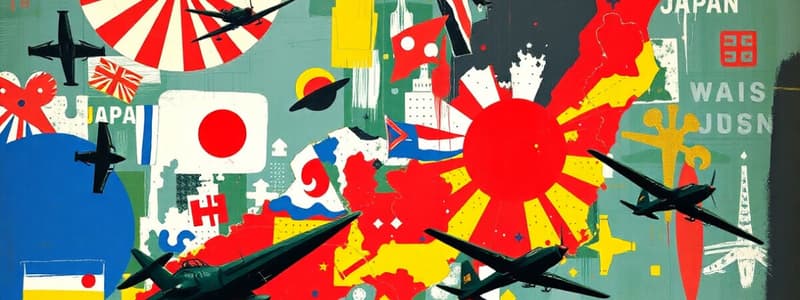Podcast
Questions and Answers
What contributed to Japan's expansionist foreign policy during the 1930s?
What contributed to Japan's expansionist foreign policy during the 1930s?
- Support for the League of Nations' principles
- Focus on peaceful coexistence with neighboring nations
- Need for additional resources to support economic growth (correct)
- Desire for increased diplomatic relations with Western countries
Which event significantly strained relations between Japan and the USA in the 1930s?
Which event significantly strained relations between Japan and the USA in the 1930s?
- The conclusion of the First Sino-Japanese War
- The signing of the Treaty of Versailles
- The implementation of the US trade embargo on Japan (correct)
- The Japanese occupation of French Indochina
How did the Japanese leadership in the 1930s demonstrate rising militarism?
How did the Japanese leadership in the 1930s demonstrate rising militarism?
- By prioritizing diplomatic negotiations over military actions
- By increasing the military's influence in political decisions (correct)
- By focusing solely on economic policies
- By advocating for non-military solutions to international conflicts
What was a direct consequence of the League of Nations' failure in the 1930s?
What was a direct consequence of the League of Nations' failure in the 1930s?
What was the Greater East Asia Co-Prosperity Sphere?
What was the Greater East Asia Co-Prosperity Sphere?
Flashcards are hidden until you start studying
Study Notes
Causes of World War II in the Asia-Pacific
Crises in Japan
- Economic crisis in the 1930s led to political instability and increased public support for militaristic and expansionist policies.
- Overpopulation created pressure on resources, prompting Japan to seek new territories for settlement and resources.
- Growing military influence transformed Japanese politics, with military leaders gaining significant control over government decisions.
- Japan aimed to establish itself as a dominant power in Asia and Europe, leading to aggressive foreign policies and expansion attempts.
- An alliance with Britain initially provided diplomatic support but became strained as Japan pursued its own interests in Asia.
- The First Sino-Japanese War (1894-1895) intensified conflicts with China, establishing a pattern of aggression that continued into the 1930s.
- The Twenty-One Demands (1915) exacerbated tensions with China, as Japan sought to increase its control over Chinese territory and influence.
- Relations with the USA deteriorated due to widespread American racism against Japanese immigrants, fueling animosity.
- Dissatisfaction with the Paris Peace Conference decisions, where Japan's territorial ambitions were not fully recognized, led to further tensions.
- Unhappiness with outcomes of the Washington Naval Conference (1921-1922) increased Japan's perception of Western powers as hostile, contributing to its isolation and subsequent militarism.
Japan's Expansionist Foreign Policy
- Japan's quest for natural resources was driven by industrial expansion and need for raw materials, leading to imperialistic pursuits.
- Rise of militarism in leadership, particularly among the army factions, pushed the government towards aggressive foreign interventions.
- The concept of the Greater East Asia Co-Prosperity Sphere aimed to create a bloc of Asian nations under Japanese influence, promoting a vision of regional unity against Western colonial powers.
Weaknesses of the League of Nations
- The League failed to address Japanese aggression during the Mukden Incident (1931) and subsequent invasion of Manchuria, demonstrating its ineffectiveness.
- Inability to intervene effectively during the Second Sino-Japanese War (1937-1945) further revealed the League's weaknesses in upholding collective security.
Japan's Responses to World Developments in the 1930s
- A US trade embargo on Japan in 1941 severely restricted its access to oil and other vital resources, prompting desperate measures.
- The war in Europe diverted global attention but presented opportunities for Japan to expand its territories in Asia.
- The attack on Pearl Harbor on December 7, 1941, marked a pivotal moment, as Japan aimed to incapacitate the US Pacific Fleet and ensure its expansion in Southeast Asia.
Studying That Suits You
Use AI to generate personalized quizzes and flashcards to suit your learning preferences.




